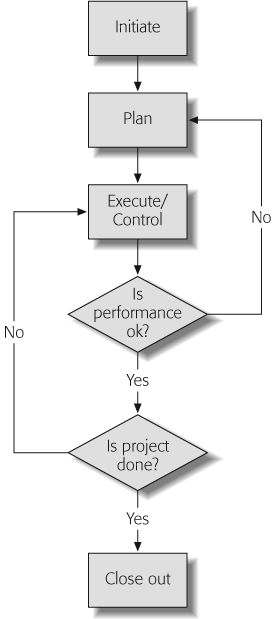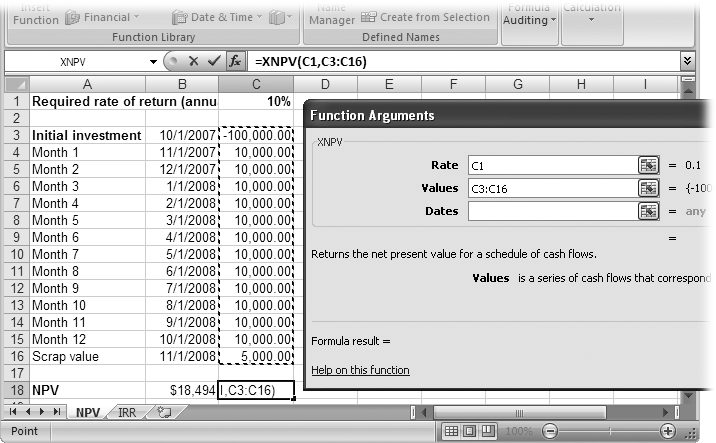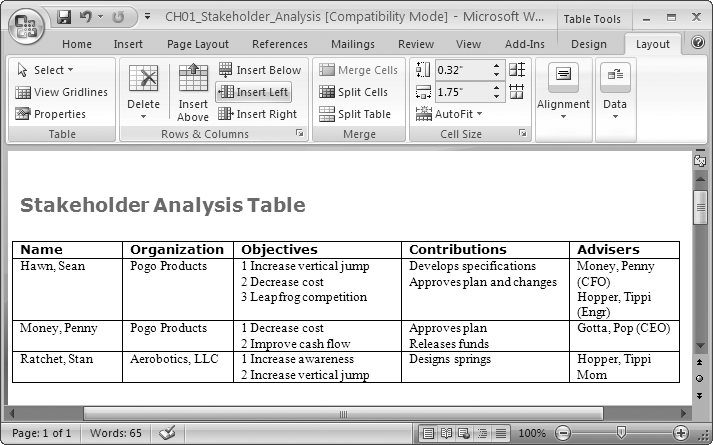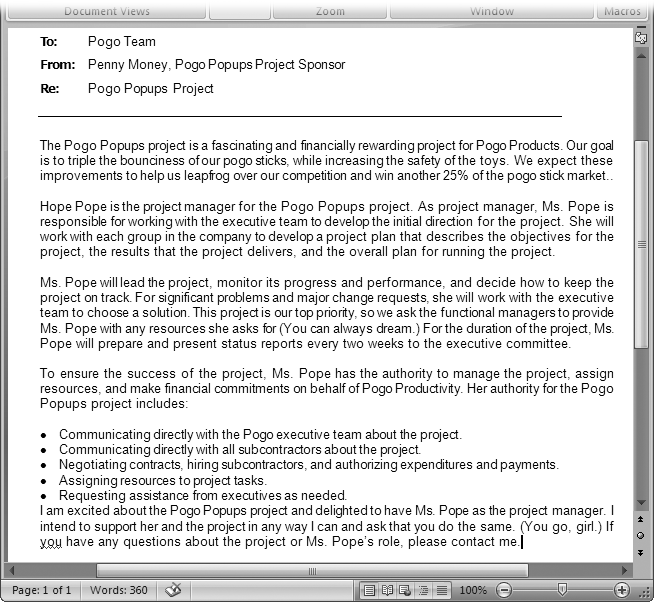Microsoft Project is brimming with features to help you manage any kind of project, but you have to know something about project management to make those features sing. If your boss hands you a project to manage, and you ask what she means by project and manage, this chapter is for you.
This chapter explains what makes a project different from day-to-day work. You’ll learn what project management is at a high level—and why it’s worth the effort. Project management helps you deliver the right results on time, within budget, and without going into crisis mode. When a project falters, project management techniques also help you get it headed back in the right direction.
But before it even begins, a project has to make it through a selection process. Just like a major-league baseball player waiting for a good pitch before he swings, you’ll learn what to look for in potential projects. (Even if your boss currently mandates which projects you manage, learning to prioritize and select projects may increase your influence in the future.)
The chapter concludes with one skill that no project manager can afford to ignore: gaining and maintaining the support of project stakeholders—the folks who care about the project’s success. You’ll learn how to identify a project’s stakeholders and their expectations, and how to keep them on board so they’re there when the project needs their help.
Projects come in all shapes and sizes, from setting the date and time on a digital watch to designing a timepiece so powerful that you need a PhD to operate it.
What’s the common thread that unites all projects and makes them different from other kinds of work? Here’s one way to define a project:
A project is a unique endeavor with clear-cut objectives, a starting point, an ending point, and, usually, a budget.
Unique is the most important word in the definition above, because every project is different in some way. Assembling reinforcing steel on site for different buildings, built on different topography, during different weather conditions, constitute different projects. The building designs, site conditions, and weather make every construction job unique, even if the buildings are cookie-cutter copies. On the other hand, a crew that cuts and bends concrete reinforcing bars performs the same work every day, typically called operations, even if the dimensions of the rebars vary.
Clear-cut objectives are necessary if you want any hope of reaching the end, staying within budget, and making customers happy. Whether you call them specific, quantifiable, or unambiguous, objectives define what the project is supposed to accomplish, so everyone knows when it’s done. “Keep the cat off the kitchen counter” is work that never ends. On the other hand, an objective that you can complete, albeit with some physical risk, is “Remove the cat from the Thanksgiving turkey carcass.”
Although some projects seem interminable, a project begins at one point in time and ends when it achieves its objectives. When the construction crew wires the last rebar into place on site and the inspector approves the work, the crew’s ready to move on to the next project. However, if the end always seems just out of reach, poorly defined objectives are usually to blame. You’ll learn how to define objectives in Chapter 2.
Budgets play a role in most projects, because very few people consider money irrelevant. In addition to achieving the project objectives within the desired timeframe, you also have to keep the price tag within an acceptable range.
Note
Dr. Joseph M. Juran, best known for his work on quality management and the impetus for today’s Six Sigma methodology, described a project as a problem scheduled for solution. The concept is the same: The problem to solve helps identify the project objectives. When you schedule the problem for solution, you determine the project’s start and end dates.
Project management is the art of balancing the project objectives against the con-straints of time and budget. Of course, achieving that balance requires skill, experience, and a boatload of techniques. This section gives you a glimpse of what happens from a project’s infancy to its old age.
Novices sometimes think of project management as building a sequence of tasks, but those in the know recognize that project management starts before a project officially begins, and doesn’t end for a while after the project’s objectives are achieved. There’s no one way to manage projects, but most methodologies cover the following five phases (also illustrated in Figure 1-1):
Getting started. Often called initiating, the first phase of project management is short, but important. It’s your only opportunity to get the project off to a good start. In this phase, you answer questions like “Why are we doing this project?” and “Do we really want to do it?” The initial attempts to describe the purpose of a project may produce vague results like “Launch a Web site to improve customer service.” But as you identify the project stakeholders (Gaining Support for a Project), you learn what the project is about and what the stakeholders hope to achieve. The more specifically you describe your project’s objectives, the greater your chances for success.
Neglecting to line up support for a project (Gaining Support for a Project) is all too common, and it’s always a big mistake. A project needs buy-in from its stakeholders to survive challenges like contradictory objectives, resource shortages, funding issues, and so on. What’s more, you, the project manager, need official support, too, so everyone knows the extent of your authority.
Planning. Planning, which Chapter 2 covers in greater detail, is where you lay out your road map: every objective to achieve, the work to perform, who’s going to do the work, when, and how much the whole thing will cost. Moreover, you set out the rules of the game, including how people communicate with each other, who has to approve what, how you manage changes and risks, and so on.
Performing the project. Also referred to as executing, this part of project management lasts a long time, but it boils down to following the plan. As the project manager, you keep the project team working on the right things at the right times.
Keeping things under control. In a perfect world, performing the project would be enough, because the project would always run according to plan. But because the world isn’t perfect, project managers must monitor projects to see whether they’re on schedule, within budget, and achieving their objectives. Whether someone gets sick, manufacturing asks for design changes, or your data center is plagued with locusts, something’s bound to push your project off course. In the controlling phase, you measure project performance against the plan, decide what to do if the project is off track, make the necessary adjustments, and measure once more. Chapter 14 and Chapter 15 explain how to use Project to control things.
Gaining closure. Like personal relationships, projects need closure. Before you can call a project complete, you have to tie up loose ends like closing out contracts, transitioning resources to their new assignments, and documenting the overall project performance (Cost performance). The closing phase is when you ask for official acceptance that the project is complete—your sign that your job is done. Chapter 18 describes the information to collect, and different ways to archive it.
The five phases of an unmanaged project go something like wild enthusiasm, dejected disillusionment, search for the guilty, punishment of the innocent, and promotion of those not involved. An unmanaged project is like a black hole that sucks up every person, machine, and dollar—and still doesn’t deliver what it’s supposed to. Despite the unpleasant alternatives, many organizations fear that project management requires bureaucratic and inflexible procedures, and may even make projects take longer. On the contrary, planning projects and managing the plan provide many benefits including the following:
Project Planning, Scheduling & Control by James P. Lewis (McGraw-Hill) bucks the trend in project man-agement books by providing an easy-to-read, even amusing, description of one way to manage projects.
A Management Framework for Project, Program, and Portfolio Integration by R. Max Wideman (Traf-ford Publishing) tries to simplify project management—and for the most part succeeds.
TenStep, Inc. (www.tenstep.com) offers a project management approach that predictably takes 10 steps from start to finish. This approach can be adapted to projects, large and small. If you register on the Web site (for free), you can mine a mother lode of additional project management wisdom.
Happy customers. Whether a project is for outside customers or groups within your organization, customers like to get what they want when they want it. Because the first step in project management is finding out what a project’s supposed to do, your customers are more likely to get the results they expect. And by keeping the project under control, you’re also more likely to deliver those results on time and at the right price.
Objectives achieved. Without a plan, projects tend to cultivate their own agendas and people forget the point of their work. A project plan ties a project to specific objectives, so everyone stays focused on those goals. Documented objectives also help you rein in the renegades who try to expand the scope of the project.
Timely completion. Finishing a project on time is important for more than just morale. As work goes on for a longer duration, costs increase, and budgets blow to bits. In addition, you may lose the resources you need or prevent other projects from starting. Sometimes, time is the ultimate objective; for instance, when you’re trying to get a product to market before the competition.
Flexibility. Contrary to many people’s beliefs, project management makes project teams more flexible. Project management doesn’t prevent every problem, but it makes the problems that occur easier to resolve. When something goes wrong, you can evaluate your plan to quickly develop alternatives—now that’s flexibility! More importantly, keeping track of progress means you learn about bad news when you still have time to recover.
Better financial performance. Most executives are obsessed with financial performance, so many projects have financial objectives—increasing sales, lowering costs, reducing expensive recalls, and so on. Project management is an executive crowd-pleaser, because it can produce more satisfying financial results.
More productive, happier workers. Skilled workers are hard to come by, and usually cost a bundle. People get more done when they can work without drama, stress, and painfully long hours. Moreover, they don’t desert the ship, so you spend less on recruiting and training replacements.
There’s never a shortage of projects, but there’s not enough time, money, and staff in the world to do them all. Before you begin managing a project, make sure it earns its place in the project portfolio. Throwing darts or pulling petals off daisies isn’t the answer. You’re better off knowing what’s important to your organization, and picking projects that support those objectives.
Project selection criteria are just as helpful once projects are underway, because projects don’t always deliver what they promise. If a project isn’t meeting expectations, you can decide whether to give it time to recover or cut it loose. Similarly, if a juicy new project appears, you can compare its potential results to those of projects already in progress to see if it makes sense to swap it for a project that’s partially complete.
Note
Selection criteria can save time and effort before the selection process even starts. People thinking about proposing a project can evaluate potential results before facing the selection committee. If the results don’t pass the test, there’s little point in presenting the project to management.
To make good decisions, you need some kind of consistent selection process, whether you’re a small business owner allocating limited resources or a committee setting up a multiproject portfolio. You can evaluate the candidates, and choose the projects with the most compelling results. When you run out of money and resources, you can put any remaining winners on the waiting list.
Some projects are no-brainers, like the ones needed to satisfy government regulations. For example, companies that want to stay in business have to conform to the accounting requirements of the Sarbanes-Oxley Act. On the other hand, you can cull projects by picking the ones that support the organization’s mission and business objectives. If your company dabbles in widgetry, the goal might be getting your tools to market before the competition. In the healthcare industry, safety trumps speed, because recalling devices already implanted in people is going to hurt the patients and the company pocketbook. Any time you begin to describe a project by saying, “It would be nice…” you may as well stop right there—unless you can link the project to quantifiable business objectives as well.
1. Someone proposes a project. Project sponsors or project managers usually prepare a proposal to sell the project to the review board—why the project is worthwhile, what benefits it provides, and how it fares against the selection criteria.
2. The project review board evaluates proposals. The project review board meets on a regular schedule to evaluate proposed projects. People who propose projects get a chance to make their pitch, which usually includes rigorous Q&A sessions with the board members to clarify ambiguous points. After the presentations, the board discusses the mer-its of the projects, how they fit with the business objectives, as well as any conflicts or issues they see.
3. The board approves or rejects projects. The board decides which projects get to move forward, and notifies proposers of the fate of their projects, preferably with reasons for the decision.
Here are some of the more common business objectives that trigger projects:
Increase revenue
Improve profitability
Increase market share
Reduce price to remain competitive
Reduce costs
Reduce time to market
Increase customer satisfaction
Increase product quality or safety
Reduce waste
Satisfy regulatory standards
Increase productivity
Although some projects get a free pass due to regulatory requirements or because the CEO says so, most have to earn their spot in the project line-up. Because business objectives vary, you need some sort of common denominator for measuring results—which often comes down to money. This section describes the most common financial measures that executives use, and the pros and cons of each.
Whether you’re trying to increase revenue, reduce costs, or improve product quality, you can usually present project benefits in dollars. The winner is the project that makes the most of the money spent on the project. Of course, to calculate financial results, you need numbers; and to get numbers, you must do some prep work and estimating (Ways to Estimate Work). You don’t need a full-blown project plan (Project Planning in a Nutshell) to propose a project, but you do need a rough idea of the project’s potential benefits and costs. That’s why many organizations start with feasibility studies—small efforts specifically for determining whether it makes sense to pursue a project further.
Note
If some business objectives are way more important than others, you may want to evaluate the projects that support those killer objectives first. Then, if you have money and resources left over, you can look at projects in other areas of the business.
Risk is another consideration in selecting projects. Suppose a project has mouth-watering financial measures and heart-stopping risks. Project proposals should include a high-level analysis of risks (Managing Quality), so the selection committee can make informed decisions.
Payback period is the time a project takes to earn back what it cost. Consider a project that reduces warranty repairs by $10,000 each month, and costs $200,000 to implement. The payback period is cost of the project divided by the money earned or saved each month:
Payback period = $200,000 / $10,000 per month = 20 months
Payback period has simplicity on its side. The data you need is relatively easy to obtain, and nonfinancial types can follow the math. But if you get really finicky about it, payback period has several limitations:
It assumes enough earnings to pay back the cost. If your company stops selling the product that the warranty repair project supports, the monthly savings may not continue for the calculated payback period, which ends up costing money.
It ignores cash flows after the payback period ends. Projects that generate money early beat out projects that generate more money over a longer period. Consider two projects, each costing $100,000. Project #1 saves $20,000 each month for only 5 months. Project #2 saves $10,000 each month for 24 months. Project #1’s payback period is 5 months compared to Project #2’s 10 months. However, Project #2 saves $240,000, whereas Project #1 saves only $100,000.
It ignores the time value of money. There’s a price to pay for using money over a period of time, just like the interest you pay on the mortgage on your house. Payback period doesn’t account for the time value of money, because it uses the project cost as a lump sum, regardless how long the project takes and when you spend the money. The measures in the next sections are more accurate when a project spends and receives money over time.
Net present value (NPV) takes the time value of money into account, so it provides a more accurate picture of financial performance than does payback period. The time value of money is another way to say that money isn’t always worth the same amount—money you earn in the future isn’t as valuable as money you earn today. For example, the value of your salary goes down as inflation reduces what each dollar of your paycheck can buy each year. Conversely, you pay a price for using money, which is exactly like the interest you pay on a house mortgage.
NPV starts by combining project income (earnings or savings) and costs into cash flows. If you earn $4,000 one month and spend $3,000 on living expenses, your net cash flow is $1,000. Then, NPV uses a rate of return to translate the cash flows into a single value in today’s dollars. If NPV is greater than zero, the project earns more than that rate of return. If NPV is less than zero, the project return is lower. Where does this magical return come from? In most cases, you use the rate of return that your company requires on money it invests. For example, if your company demands a 10 percent return to invest in a project, you use 10 percent in the NPV calculation. If the NPV is greater than zero, the project passes the company’s investment test.
NPV has two drawbacks. First, it doesn’t tell you the return that the project provides, only whether the project exceeds the rate of return you use. You can compare NPV for several projects and pick the one with the highest value, but executives like to see an annual return. The second drawback is that NPV is hard to explain to non-financial folks. (Luckily, however, most people picking projects are well-versed in financial measures.)
Figure 1-2 uses the purchase of a machine as a simple example of net present value. The machine costs $100,000 and saves $10,000 in production costs each month it operates. The machine is obsolete at the end of the first year, at which point its value as a chic boat anchor is $5,000.
Figure 1-2. The XNPV function interprets negative numbers as money spent—like $100,000 for a new packaging machine. Positive numbers represent money coming in (as a result of the improved equipment). If you spend and earn money on the same date, simply enter the net amount (the income minus the expense). Because NPV in this example is greater than zero, the machine provides a return greater than the required annual 10 percent return.
To avoid frenetic finger-work calculating NPV on a handheld calculator, try the XNPV function in Microsoft Excel. You provide the required rate of return, the cash flows the investment delivers, and the dates on which they occur (remember the value of money changes over time). The XNPV function does the rest.
Note
If cash flows occur on a regular schedule like once a month, you can use the Excel NPV function, which doesn’t even require dates. The NPV function assumes a regular schedule, and you simply input the rate of return between each cash flow. If the annual rate is 10 percent and you have monthly cash flows, you enter the rate as 10 percent divided by 12, or .833 percent. The biggest drawback to the NPV function is that it accepts no more than 29 values, which isn’t enough for monthly cash flows for several years.
To use the XNPV function, do the following:
In an Excel workbook, fill in one cell with the rate of return you want to use, and then enter the cash flows and dates in two of the workbook columns, as shown in Figure 1-2.
The dates and cash flows don’t have to be side by side, but you can read the workbook more easily when they are.
In Excel 2007, select the cell in which to insert the function, and then click the Formulas tab. On the left side of the ribbon, click Insert Function.
In Excel 2003, you choose Insert → Function. In either version of Excel, the Insert Function dialog box opens with the “Search for a function” box selected.
In the “Search for a function” box, type XNPV.
In the “Select a function” list, Excel displays and selects the XNPV function. It also lists related financial functions.
Click OK to insert the function into the cell, and then fill in the boxes for the function arguments.
In addition to adding the function to the cell, Excel opens the Function Arguments dialog box, shown in Figure 1-3, which presents the three arguments for the function with hints and feedback.
Click OK to complete the function and close the dialog box.
The likely favorite of financial types, internal rate of return (IRR) tells you the annual return that a project delivers, taking into account the time value of money. IRR is like the annual percentage yield (APY) that you earn on a savings account, which includes the compounded interest you earn during the year. If your project delivers an IRR greater than the return your company requires, you’re golden.
Figure 1-3. To fill in an argument, click the box, such as Rate. Then, in the worksheet, click the cell (or cells) that contain the input. For example, for Values, you can drag over all the cells that contain the cash flows.
Just like NPV, IRR depends on when cash flows in or out. For example, money you spend up front drags the IRR down more than money you spend later on. Likewise, if a project brings money in early, the IRR is higher than if the income arrives later.
Excel’s XIRR function calculates IRR given cash flows and the dates on which they occur, as shown in Figure 1-4. For the mathematicians in the audience, IRR doesn’t have a formula of its own. The way you calculate IRR by hand is by running the NPV calculation with different rates of return until the answer is zero—that return is the IRR. The steps to insert the XIRR function into a worksheet are similar to those for XNPV in the previous section.
Sponsorship is important during the selection process, but support becomes crucial once projects start up. Projects rarely finish without running into some kind of trouble, and you often need help digging them out. Alas, many people lend a hand only if there’s something in it for them, which is why identifying the people who care about a project (the stakeholders) is so important.
Stakeholders can play a part in a project from proposal to the final closeout. During the planning phase, stakeholders help define the project and evaluate the project plan. A few lucky stakeholders cough up the money to fund the project. During the execution phase, stakeholders help resolve problems, make decisions about changes, risk strategies, and whether to fork over more money if necessary. At the end of a project, some of the stakeholders get to decree the project complete, so everyone can go on to another project.
Figure 1-4. XIRR includes a third argument called “guess,” which is the first return you use in the search for the IRR. If you leave the guess argument blank, Excel uses 10%. Depending on whether the resulting NPV is positive or negative, the XIRR function tries a different value until NPV equals zero.
Commitment comes from all levels of an organization, from the executive-level project sponsor to the people who work on the project every day. Project stakeholders get their name because they have a stake in the outcome of the project. They either give something to your project, like the managers who provide the resources you use; or they want something from it, like the customer who implements the software system a project delivers.
Identifying stakeholders can be tough. Some don’t realize they’re stakeholders, like the development team that learns about a project when they receive the list of impossible requirements from sales. Other people pretend to be stakeholders, but aren’t. For example, an engineering department gets chummy because they see your project as an inexpensive way to get their new database. If you’re not careful, your project gains extraneous requirements, but of course, no additional money.
Here are the main types of stakeholders, how you identify them, and some hints on keeping them happy:
Project customers are easy to spot, because they’re the ones with the checkbooks. Pleasing the stakeholders who fund your project is a matter of delivering the financial results they expect (Common Project Selection Criteria). Stay on top of financial performance (Is the Project Within Budget?) so you can explain financial shortfalls and your plan to get back on track. The people who control the pocketbook can be formidable allies if other groups are trying to expand the project.
Because customers foot the bill, they usually have a lot to say about the project objectives, requirements, and deliverables. Of course, the person who cuts the check isn’t often the person who defines requirements, but they both represent the project’s customer. For instance, if the project is a college search, your teenager may pick a university even if you pay the tuition and board. Customers also approve documents, intermediate results, and the final outcome. Approvals are much easier to come by if you work closely with customers during planning to identify objectives and what they consider success.
Project sponsors are the folks who want the project to succeed, and have the authority to make things happen, for example, the vice president of manufacturing who’s backing an assembly line upgrade project. If you, as a project manager, don’t have that kind of authority, you may depend on project sponsors to confer some of their authority to you. A project sponsor’s role is to support the project manager and the project team to make the project a success. After guiding a project through the selection process, the project sponsor’s next task is to sign and distribute a project charter (Documenting Project Stakeholders), which publicizes the new project and your authority as the project manager.
A project sponsor can help you prioritize objectives, tell you which performance measures are critical, and guide you through the rapids of organizational politics. The sponsor can also recommend ways to build commitment or fix problems. Sometimes, project sponsors are also project customers, whether for internal projects or for those that deliver products to external customers.
If your authority isn’t enough or the project hits serious obstacles, the project sponsor can step in. While project sponsors want their projects to succeed, they expect you to manage the project. Dropping problems at their doorstep every few minutes won’t win their hearts, but neither will hiding problems until it’s too late. If you need help, don’t be afraid to get your sponsor involved.
Functional managers (also called line managers) run areas like engineering, marketing, or IT. They have quotas and performance measures to meet in addition to supervising the resources in their departments. Project resources almost always come from these departments, so you have to learn to work with these colleagues.
The easiest way to win over functional managers is to let them do their jobs. Don’t tell them who you need (unless you already have a great working relationship.) Instead, specify the skills you need and the constraints you face, like cost, availability, or experience. Then, after the managers provide you with resources, do your best to stick to the assignment dates you requested. When schedules slip, notify functional managers quickly so you can work out an alternative.
Team members who do project work are stakeholders, too, because they perform the tasks that make up the project. Other types of stakeholders often do double duty as team members, for example, when a customer defines requirements.
Keeping team members happy is a combination of reasonable workload, meaningful work, and a pleasant work environment. Communication is as important with team members as it is with every other type of stakeholder. Team members want to know how their tasks support the big picture, what their tasks represent, and when they’re scheduled to perform them.
You already know that project managers are stakeholders, because your reputation and livelihood depend on the success of your projects. The project manager is easy to identify when it’s you. How to make yourself happy is something you have to figure out for yourself.
The process of building a project plan (Project Planning in a Nutshell) helps you identify many project stakeholders. For instance, the purpose of the project and who benefits from it tell you who the customer is as well as the project sponsor. Project objectives help you identify which groups participate in achieving those objectives. The responsibility matrix (Who’s Responsible for What) identifies the groups involved in a project and their level of involvement, so it acts as a checklist of stakeholder groups. Of course, you still must identify the specific people to work with within those groups. When you start to build your project team, the list of functional managers and team members falls into place.
As projects pick up momentum, your ability to remember details quickly falls away. Stakeholders are so important to projects, you can’t afford to forget them. As you identify stakeholders during planning, create a stakeholder analysis table. Names and type of stakeholder aren’t enough. Include information about the people’s roles, which objectives matter to them the most, and whom they listen to.
Figure 1-5 shows a sample stakeholder analysis table, which you can download from www.missingmanuals.com/cds. Look for the Word file “Ch01 Stakeholder_Analysis.doc.”
Figure 1-5. When you use a table in a Word document, you can add a new row to the table by pressing Tab when you’re done typing in the last cell of a row. To add an additional objective or contribution to a table cell, with the insertion point at the end of the cell text, press Enter.
Here’s the information that’s helpful to collect about each person who acts as a stakeholder:
Organization or department. Knowing where a stakeholder works helps you remember the objectives they care about, and whether they should participate in different activities. For instance, if your company wants to keep strategy sessions confidential, you don’t want to invite external stakeholders to them.
Objectives. List the objectives that a stakeholder cares about—from their hottest button to coolest. If you need help rallying stakeholders around an objective, the Objectives column helps you find your allies.
Contributions. List what the stakeholder does for the project. Contributions in the stakeholders analysis table are different than the responsibilities in a responsibility matrix (Who’s Responsible for What). In the stakeholder table, you specify the specific contributions that individuals make to the project in their roles as stakeholders.
Advisors. The people to whom stakeholders listen are great sources for tips on presenting information effectively, or which options a stakeholder might prefer.
A project that gets the OK to proceed needs publicity like movies do. You want people to know the project is starting, and why it’s so important. Most important, you want the entire team to get fired up over their new assignments. The project manager needs some publicity, too. Your authority comes from your project and project sponsor, not your position in the organization, so people need to know how far your authority goes. The project charter is like a project press release—it announces the project and your responsibilities and authority as its manager.
A project charter doesn’t impress anyone unless it comes from someone powerful enough to bestow you with authority, like the project sponsor or the project customer. On the other hand, don’t have the biggest kahuna distribute the charter unless that person actually knows something about the project. You need authority, but credibility is important as well.
You may have to tactfully suggest that the project customer or sponsor develop and distribute the project charter. You can often get the project charter out more quickly by authoring it yourself, so the sponsor has only to sign and send it.
A project charter is pretty simple, as Figure 1-6 shows. (You can download a sample project charter, Ch01 Project_Charter.doc, from www.missingmanuals.com/cds.)
Here are typical elements of a project charter:
Project name. A catchy name that rolls off everyone’s tongue is wonderful, but a brief name that identifies the project will do.
Purpose. The mission statement works well as the purpose, because it’s a highlevel view of the reason for the project. If you haven’t crafted a mission statement yet, simply summarize what the project is supposed to achieve.
Project manager. Announce the project manager for the project. If you’re writing the project charter for a sponsor to sign, don’t be afraid to blow your own horn. Stakeholders need to know who you are, and why you’re the person who’s going to make this project a success.
Project manager’s duties. Summarize the duties of the project manager. This brief introduction to the project manager’s tasks can warn people about what a project manager may expect from them—and educate people about the myste-rious activities that project managers perform.
Project manager’s authority. Here’s where the sponsor or customer sprinkles authoritative fairy dust on you. Much like a power of attorney, this section tells everyone that the sponsor or customer authorizes you to perform activities, such as hiring contractors or dipping into the project emergency fund.
The official commitment to the project. Don’t forget to include a brief bullet point that confirms in writing that the sponsor or customer supports the project and the project manager.
Now that the introductions are out of the way, it’s time to start planning your project. The next chapter provides the big picture of a project plan—all the pieces that go into one, and why they’re important. From there on, you’ll learn the finer points of using Project and other programs to build and manage a project schedule.
Get Microsoft Project 2007: The Missing Manual now with the O’Reilly learning platform.
O’Reilly members experience books, live events, courses curated by job role, and more from O’Reilly and nearly 200 top publishers.







